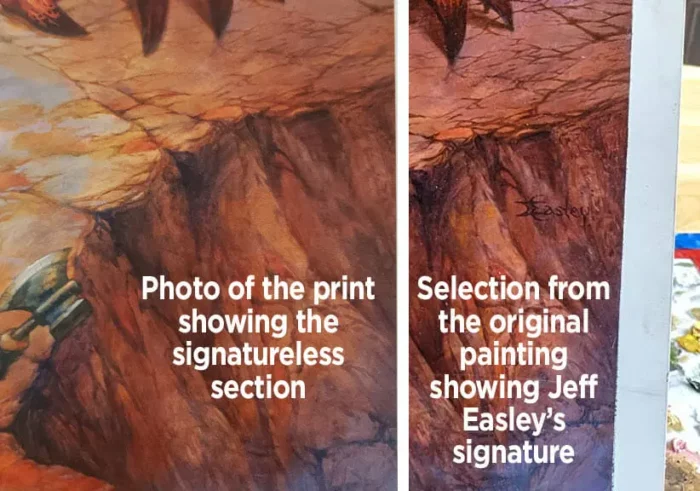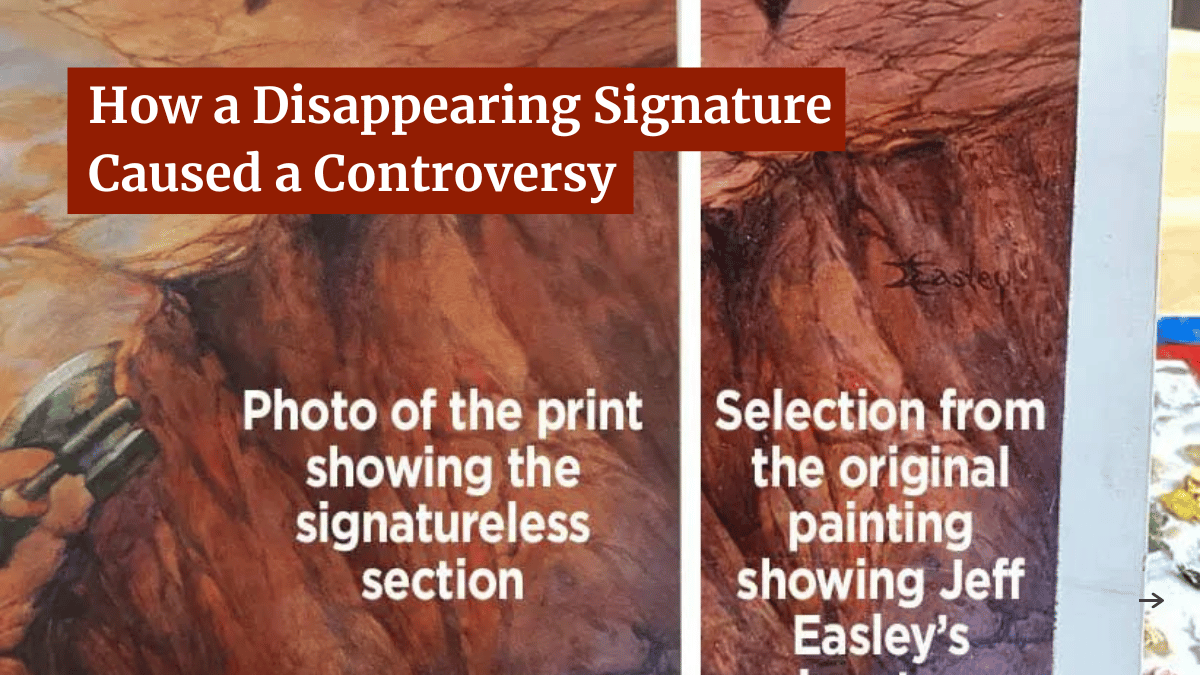The Case of the D&D Poster and the Missing Signature

Jeff Easley is a fantasy artist who is best known for his work on cover art for various Dungeons & Dragons books, as well as multiple cards for the game Magic: The Gathering. Both of which are properties of Wizards of the Coast (WotC).
Fans of Easley were excited to learn that he had been asked to work on a poster for an upcoming film based on D&D, Dungeons & Dragons: Honor Among Thieves. They shared that excitement with Easley when, on April 2nd, Easley posted images of the work in progress on a fan group.
However, according to a report by Egg Embry at Geek Native, that fan support turned somewhat sour as, on April 28, he added a new comment to the thread that said:
“Finally scored a copy of the giveaway print….THEY TOOK MY SIGNATURE OFF THE PAINTING!”
Jeff Easley
Screenshots quickly highlighted how, even though his artwork was clearly used for the poster, his signature had clearly been removed from the lower right hand corner of the painting.

The blame initially fell on Hasbro, the parent company of WotC, or eOne, the production company behind the film. Hasbro and WotC, in particular, were easy targets as they had been involved in a controversial incident where agents from the Pinkerton Detective Agency were sent to retrieve pre-release Magic: The Gathering cards that were mistakenly sent to a YouTuber.
However, it was later revealed that it was Paramount that was responsible for the distribution and the marketing of the film. This means that it was likely they, or one of their contractors, who made the decision.
To that end, Jeff did seem to walk back some of his anger, replying to Geek Native’s Facebook post saying, “To be fair, none of the other promo art I saw was signed. None of the 50’s and 60’s poster artists ever got credit for their work. I would just think my association with early-ish TSR would be the only reason I got the job.”
In the end, it seems like much of the controversy has already blown over. However, it’s still a case worth evaluating both to figure out what happened and, more importantly, if it could have been prevented.
What (Most Likely) Happened
Though there are many moving parts in this story and Paramount has not commented, it’s pretty obvious what most likely happened: There was a clash of citation standards between WotC and Paramount.
Citation standards are inherently complicated. However, on a fundamental level, they have to answer three key questions:
- When is Citation Required? Simply put, under what circumstance is someone using another’s work required to provide attribution to them.
- What Citation is Required? Basically, what elements should be in the citation? Should it be the person’s name, should one identify where the work came from? Etc.
- How is the Citation Affixed? Is the citation provided as a link to the source? As a footnote at the end of the document? Or, as in this case, as a signature on the painting.
Citation standards vary wildly depending on the type of work, where it is published and what the intent of the new work is. For example, Facebook and Twitter have very different citation standards from one another. Likewise, a formal college essay has a different standard than an informal letter. Also, a fictional book has a different standard than an educational one.
This makes citation code switching an important skill for authors of all types to master. The ability to move across different media without violating the ethics of any one of them.
Here, it’s pretty clear that the citation standards WotC has for its games and cards are different from the standards Paramount has for its movie posters. Though the medium is the same, namely an oil painting, the industry and the intended use of each are different.
Though it’s unclear who made the exact decision, it was likely based not on any desire to deny Easley credit, but simply to follow standards and guidelines, either written or unwritten, that are simply the norm.
Easley noted this himself, saying that none of the other promotional material was signed and, though several commenters did point to cases where promotional movie posters were signed, those appear to be the exception, not the norm, especially in modern times.
How it Could Have Been Avoided
To be clear, this story doesn’t appear to be having a major impact on any of the people involved. However, it’s also easy to see how things could have been much, much worse.
Here, the solution is fairly obvious: Paramount should have at least considered the citation standards of WotC and that industry as a whole. While there are difficulties in doing so due to contracts and agreements that the movie industry has over who should be credited and for what, it makes some sense to pay respect to the standards of the work you are basing your film on.
We’ve seen this before as at least two religious leaders have been accused of plagiarism for doing the reverse, applying the citation standards of a sermon to a non-fiction book they were publishing.
When dealing with works, such as a movie poster based on the work of a D&D artist, that cross different types of media and have different citation standards, it’s generally wise to follow the more stringent guidelines. Paramount did not do that in this case.
It’s a simple and understandable mistake, but one that can be easily avoided moving forward. One simply has to be aware that the pitfall is there.
Bottom Line
To be 100% clear, I don’t think Paramout, WotC, Hasbro, eOne or anyone involved with this story had any intention of slighting Easley. This wasn’t an attempt to deprive him of attribution, nor was this an attempt to take credit away from him or take credit for his work.
Simply put, this story involved a work that, while normally is handled one way, is handled a very different way in the movie business. This was a clash of citation standards and citation norms, nothing more.
But it’s still a good story to study and learn from. These types of clashes happen regularly, and it makes sense to examine them. After all, it’s an opportunity to learn from the missteps and avoid them in the future.
Is this the most egregious story that’s been covered on this site? Not by a long shot. However, its commonness makes it all the more important to examine, especially as generative AIs are raising new authorship and citation issues.
In the end, it’s a story without any clear villains, but an important one to understand to try and learn from.
Want to Reuse or Republish this Content?
If you want to feature this article in your site, classroom or elsewhere, just let us know! We usually grant permission within 24 hours.
